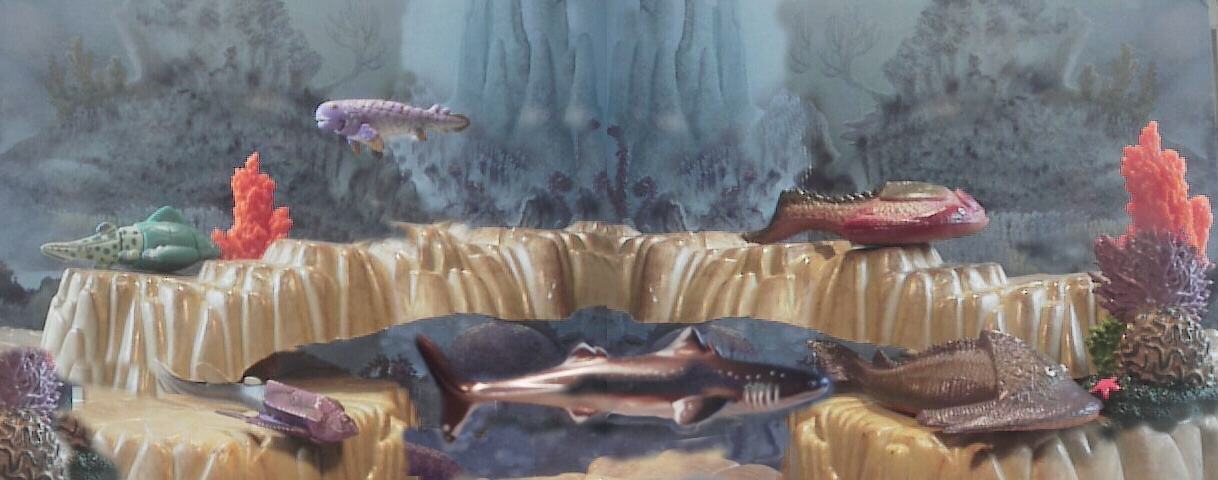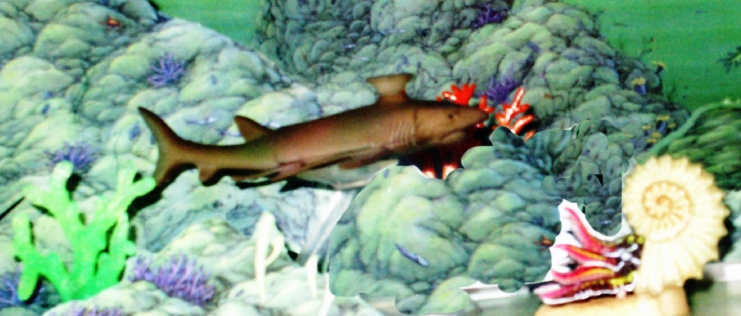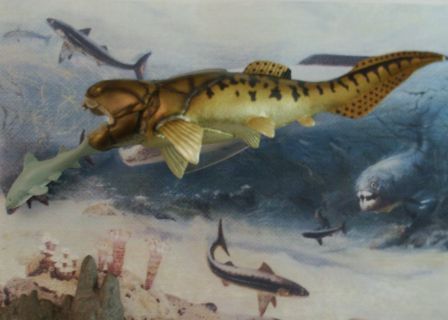
update 9/12/07 proof020606 rgk
Paleozoic Seas in the Devonian
from the Dinosaur Collector
The Devonian began about 409 million years ago and ended about 363 million years ago. During the Devonian, there were three major continental masses. North America and Europe sat together near the equator, much of their current land underneath seas, to the north lay a portion of modern Siberia, and a composite continent of South America, Africa, Antarctica, India, and Australia dominated the southern hemisphere. The first well known sharks, armored fish, lungfishes and ganoid fish (coelacanths, rhinzodonts, sturgeons and gars) appeared in the Devonian, which is frequently called the "Age of Fish."
Armored heterostracans like Drepanaspis decline after preceding Silurian and disappear in the Devonian. Ostroderms, like Hemicyclaspis, were small armored fish without jaws, and were the first fish to have bones, which they used for armor, not support; cartilage supported the body, as in modern sharks and sturgeon. They disappear from the fossil record at the end of the Devonian. Placoderms were armored fish with jaws and internal bones like Groenlandaspis, Bothriolepis and Hemicyclaspis. They evolved after the ostroderms and disappear in the following Carboniferous period. They are the most diverse type of fish in the Devonian, and some became very large. Lobe-fin fish are also diverse, like the predatory Rhizodont and Coelacanths. They are often identified as ancestral to amphibians because of their finger-like bony fins, but recent genetic studies point to a closer relationship between lungfish and early amphibians.

Stethacanthus resembled modern sharks to an extent, except for its outrageous dorsal fin - the shape of an ironing board - that it seems was part of courtship display as it is found in the males only. The top of this fin was covered in rough, tooth-shaped scales that match a patch of skin on the Stethacanthus' snout. There's evidence Stethacanthus may have been migratory, returning to particular places to mate and give birth. It could certainly swim quite fast, although not quickly enough to evade a hungry Dunkleosteus.

Dunkleosteus alternately known as Dinichthys the top predator the boney jaws act as teeth. Pigment cells suggest dark colours on its back and a silvery belly. It was 27 to 33 feet long. Its prey could have included primitive sharks, are not large or diverse. Modern telosts or boney fish are developing air bladders in fresh water. They return to replace the slow swimming placoderms later.

Coelacanths belong to the oldest lineage of fish currently known to science. The oldest found Coelacanth fossils imply that the Coelacanth fish species developed during the Devonian period. Coelacanthiform lobe-finned fish were a large group comprising about 90 valid species that were distributed worldwide in both marine and freshwaters.
Return Paleozoic Menu
 Use the Site A icon
to the new Dinosaur Collector for more Dioramas.
Use the Site A icon
to the new Dinosaur Collector for more Dioramas.
|
|